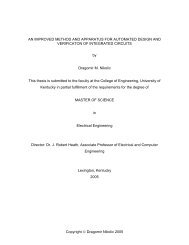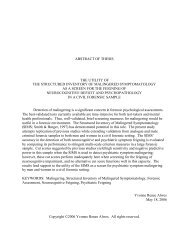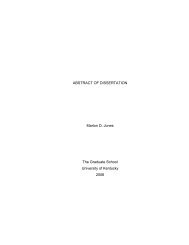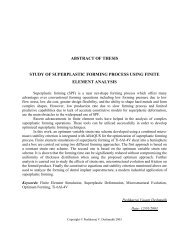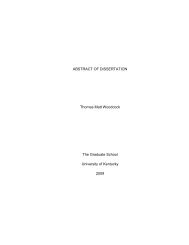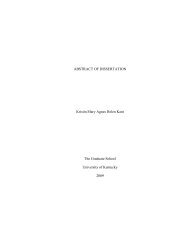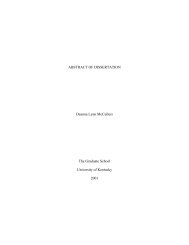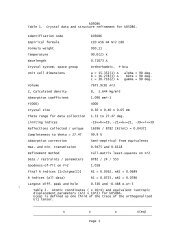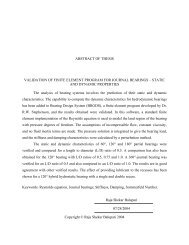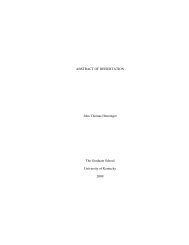Ambystoma - University of Kentucky Libraries
Ambystoma - University of Kentucky Libraries
Ambystoma - University of Kentucky Libraries
You also want an ePaper? Increase the reach of your titles
YUMPU automatically turns print PDFs into web optimized ePapers that Google loves.
presented in Tables 2.6 and 2.7, respectively. The largest A. t. tigrinum contigs contained<br />
fewer ESTs than the largest A. mexicanum contigs, probably because fewer overall A. t.<br />
tigrinum clones were sequenced, with the majority selected from a normalized library.<br />
However, it is notable that the contig with the most ESTs was identified for A. t.<br />
tigrinum: delta globin. In both species, transcripts corresponding to globin genes were<br />
sampled more frequently than all other loci. This may reflect the fact that amphibians,<br />
unlike mammals, have nucleated red blood cells that are transcriptionally active. In<br />
addition to globin transcripts, a few other house-keeping genes were identified in<br />
common from both species, however the majority <strong>of</strong> the contigs were unique to each list.<br />
Overall, the strategy <strong>of</strong> sequencing cDNAs from a diverse collection <strong>of</strong> tissues (from<br />
normalized and non-normalized libraries) yielded different sets <strong>of</strong> highly redundant<br />
contigs. Only 25% and 28% <strong>of</strong> the A. mexicanum and A. t. tigrinum contigs, respectively,<br />
were identified in common (Figure 2.2). Moreover, there are several hundred contigs<br />
were identified in common between Xenopus and <strong>Ambystoma</strong>; this will help facilitate<br />
comparative studies among these amphibian models.<br />
Functional annotation<br />
For the 10,592 contigs that showed significant similarity to sequences from the human<br />
RefSeq database, Gene Ontology (http://www.godatabase.org/dev/database/) information<br />
was obtained to describe ESTs in functional terms. Although there are hundreds <strong>of</strong><br />
possible annotations, a list <strong>of</strong> descriptors for molecular and biological processes were<br />
selected that are <strong>of</strong> interest for research programs currently utilizing salamanders as<br />
model organisms (Table 2.8). In all searches, each match between a contig and a RefSeq<br />
sequence was counted as a different ambystomatid gene, even when different contigs<br />
matched the same RefSeq reference. In almost all cases, approximately the same number<br />
<strong>of</strong> matches was found per functional descriptor for both species. This was not simply<br />
because the same loci were being identified for both species, as only 20% <strong>of</strong> the total<br />
number <strong>of</strong> searched contigs shared sufficient identity (BLASTN; E



